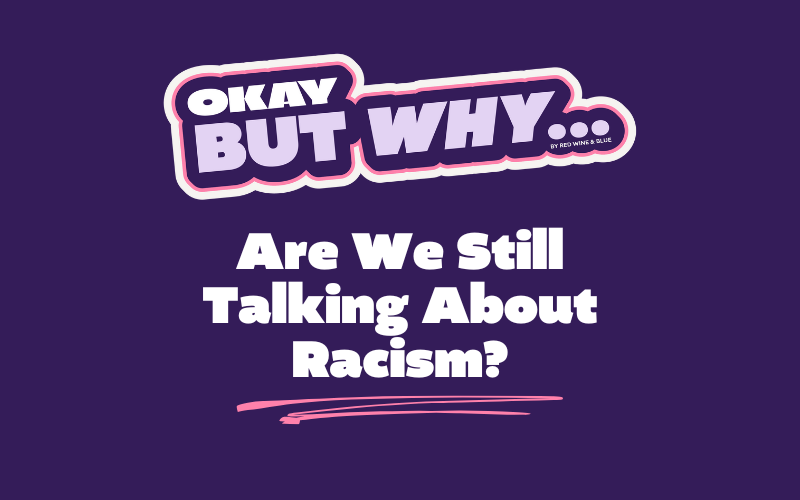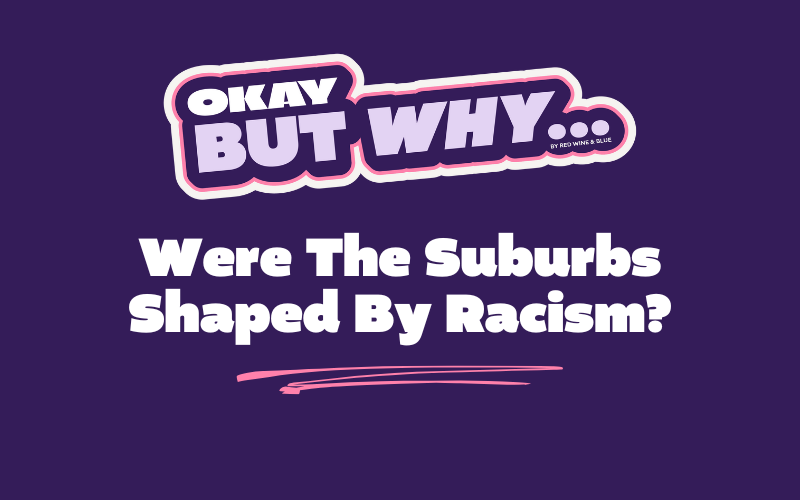
Why It’s Not Enough To Be “Not Racist”
The painful truth is that racism is a part of our history and it still exists today. It can be tough to talk about, but if we want to end racism, we have to speak honestly about it and learn how and why it has persisted. Then we can intentionally work hard to end it. If we can commit to that, we can create the America we want to see for everyone.
Why Are We Talking About Racism?
Need to step back and understand more about why we’re even talking about racism in America? We answer that question in our “Okay, But Why?” series.
What is Anti-Racism?
Racism and imbalances of power exist in America — sometimes in ways that we don’t even see — and that influences our behavior, whether we realize it or not.
Our society was built on the idea that some people are better than others and should hold all the power. That system hurts all of us. For most of us to truly understand this, we need to start looking at the world around us in new and different ways.
But it’s not enough to just recognize that racism exists and choose to not be racist. Many of us already believe that we aren’t racist. So it takes intentional work to recognize ingrained racial biases, both in ourselves and the systems around us, and take ongoing actions to make change. That is what it means to be anti-racist.
Anti-racism isn’t just a value or a philosophy, it’s a practice that we live out through our actions every day. It often requires us to step outside of our comfort zone and call out and fight racism whenever and wherever we see it.
There is a lot of incorrect information out there about the purpose of anti-racism, so let’s be clear about exactly what it is. Anti-racism is just an attack on racism, plain and simple, wherever it exists and no matter who is responsible for it. There is nothing inherently wrong with any of us based on what race we are or what power we have in society. What matters is how we choose to use our power. Do we wield it over others, or do we yield it to lift others up?
Red Wine and Blue works to practice anti-racism every day, but we don’t claim to be the experts! You can visit our library of resources below to learn more about anti-racism and start to do your own work.
Reflection
Anti-racism is not a binary, yes/no kind of thing. It’s not that you are either racist or anti-racist. It’s an ongoing practice on a spectrum. The idea of anti-racism may be brand new to you, you may have been expertly practicing it for years, or you may be somewhere in between. Take a moment and think about this.
Where are you on this spectrum, and where do you want to be?

Racism Shows Up In All the Issues That Matter to Us
One of the things that makes it hard to end racism is that it’s everywhere. It shows up in every issue that matters to us. Click on each section below to learn more.
Racism in Education
For years, extremists have been trying to stop schools from teaching a real and honest history of racism in America. They’ve challenged curriculum and taken over school boards to change policies from the inside. Diversity, equity, and inclusion programs are being cancelled. And book bans have increased year over year, with books by diverse authors or about diverse characters being banned at disproportionately high rates.
Our Freedom to Parent campaign fights book bans and other attacks on public education.
Our Project 2025 tracker shows how attacks on diversity, equity, and inclusion are straight out of the extremist playbook.
Racism in Healthcare
Black women are more than twice as likely to die during pregnancy and childbirth than white women, and Indigenous women are more than 4 times as likely! And abortion bans are disproportionately harming Black, Latino, and Indigenous women. Learn more about these health disparities from our “We Decide, Not Politicians” campaign.
We desperately need more research on healthcare disparities by race, and healthcare providers need more education and training in this area. For example, pulse oximeters don’t work as well for Black patients, a problem that has long been ignored in research. And as recently as 2016, a study found that half of white medical residents believed in biological differences between Black and white people, including that Black people have thicker skin or a higher pain tolerance — they don’t! Donald Trump and his Department of Government Efficiency (DOGE) have ended federally funded research into health disparities based on race, which will make these problems much harder to solve. Learn more about these cuts and how they’re related to Project 2025 here.
Racism in environmental policies can also cause health problems. Harmful facilities like landfills and industrial plants are often located near communities of color, which leads to negative health impacts from waste and other emissions. And historically, racism in city planning led to fewer trees and more concrete and asphalt in Black and brown neighborhoods, making the people who live there more susceptible to heat-related illnesses.
Racism and Voting Rights
There is a long history of voter suppression in our country, and extremists are still trying to disenfranchise Black and brown voters today.
In 2013, the U.S. Supreme Court ended a process called “preclearance” which was created by the 1965 Voting Rights Act. Preclearance meant that the federal government reviewed all new voting laws in states that had a documented history of racial discrimination. Since then, 29 states have passed 94 new restrictive voting laws, many of which are racially discriminatory. And the gap between white voters and nonwhite voters has increased to 18 percentage points.
Here are just some examples of restrictive voting laws:
- Voter ID laws are proven to disproportionately harm Black and brown voters because they are less likely to have a qualifying ID.
- Reducing voter registration periods or early voting periods; limiting or closing polling locations; and ending or restricting mail-in voting have all been shown to disproportionately impact voters of color.
- Restricting or criminalizing voter assistance — like handing out water and snacks to voters waiting in long lines — harms more voters of color because polling places with fewer white voters have been shown to face longer lines and wait times.
- Drawing unfair voting districts to favor a certain party, also known as gerrymandering, happens during redistricting processes and both major political parties are guilty of it! It is often accomplished by reducing minority representation across districts. After the 2022 midterm elections, gerrymandering by Republicans in North Carolina and Georgia gave the party the majority in the U.S. House in 2024, which is enabling the Trump administration to enact his agenda.
We take a deeper dive into all this here in our “Protect Your Voting Rights” campaign.
Racism and Economics
Racism has kept Black Americans from having equal opportunities to gain wealth — especially through education, employment, and land or home ownership — which is why a wealth gap persists between Black and white Americans today.
- Even after slavery ended, Jim Crow laws kept Black people from owning homes in certain neighborhoods. This led to segregated neighborhoods which still exist today.
- Agencies started defining these “Black neighborhoods” as being riskier for mortgage lending, leading to higher rates and fees, and lower property values. Black homebuyers still face this discrimination from real estate agents and lenders.
- Black veterans were denied GI benefits after World War II, which widened the gap between Black and white veterans’ home ownership, educational advancement, employment, and wealth. Those gaps persist today.
- School segregation kept Black children from getting equal educational opportunities. This also meant restricted access to career opportunities, keeping Black Americans in lower-paying jobs.
Learn more from the Center for American Progress about how these systems of racism created the current wealth gap between Black and white Americans, and learn more about economic issues like this that matter to suburban women from Momonomics.
Were the Suburbs Shaped By Racism?
“Suburban woman” is no longer code for “white woman” – no matter how much the media tries to simplify us. But the suburbs have excluded families who aren’t white for most of their history. Why – and how – did the suburbs end up so white for so long? What happened to make them more diverse, and why are some people worried that we’re reversing that progress?
The fact that racism persists in all these issues is why we practice anti-racism.
Actions from the Trump Administration
Since the Civil Rights movement, a lot of progress has been made toward creating a more equitable America for all of us. But this video from our friends at the African American Policy Forum shows how the Trump administration has unraveled so much of that progress.
Many of these actions can be traced to white Christian Nationalists who created Project 2025 and hold positions of power in Trump’s administration. Their goal is to return to an unequal society where white people hold more power. To stop this from happening, we have to do the work of anti-racism.
Reflection
If this is new to you and feels like a lot to digest, that’s normal. Explore your reaction. Lean into anything that makes you uncomfortable and resist the urge to avoid it. Instead, revisit it and try to learn more. Ask questions. Listen to the life experiences of others and look at this information from other people’s perspectives. But don’t put the burden of teaching you on Black or brown women.. See our resource library to learn more.
Being Anti-Racist Takes Work, So Let’s Do The Work!
Learn more right now by watching our past trainings and events on anti-racism.
Find a local TroubleNation group that’s doing anti-racism work in your community.
Or just stay in the know! Sign up for our email list so you can be the first to know about our future anti-racism events and opportunities to do more.
Anti-Racism Resources
Here is a non-exhaustive list of resources to get you started (or keep you going) on your anti-racist practice.
Are we missing something? Email us to let us know!
Read these books.
Visit our list of recommended anti-racism and anti-bias books on bookshop.org.
Listen to these podcasts.
Learn from our Partner Organizations.
Follow these experts and influencers online.
Austin Channing Brown
Rachel Cargle
The Conscious Kid
Kimberlé Crenshaw
Brittany Packnett Cunningham
Nikole Hannah-Jones
Sherrilyn Ifill
Blair Imani
Ibram X. Kendi
Joy Reid
Jemar Tisby
Share this information with your family and friends!
Help us reach more people with this information. Share these posts to spread the word.


